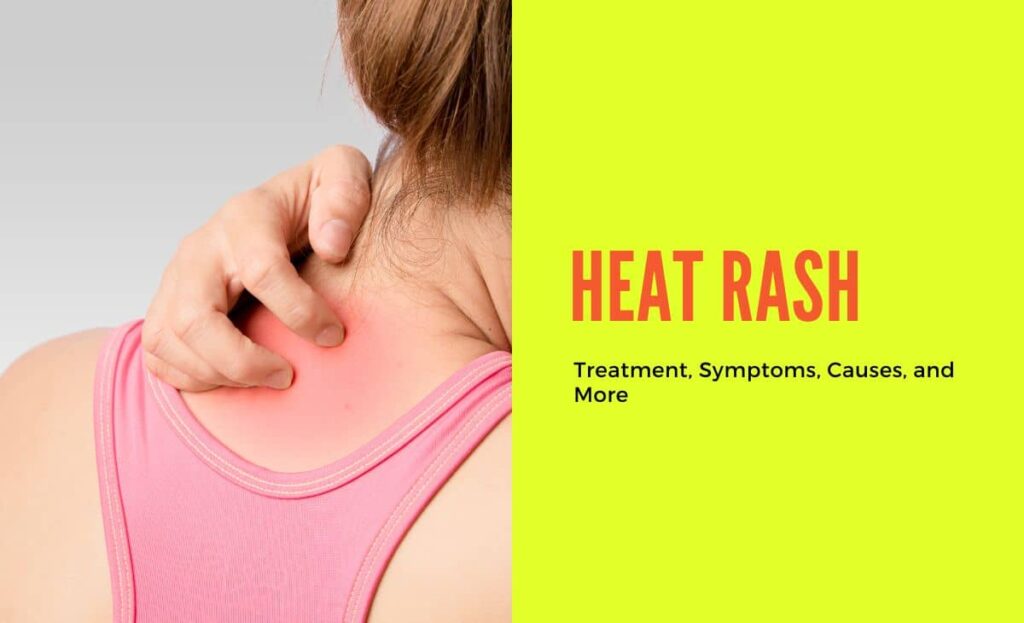Introduction
Heat rash, also known as prickly heat or miliaria, is a common skin condition that occurs when sweat gets trapped in blocked pores, leading to irritation and inflammation. While it’s usually harmless, heat rash can be uncomfortable, especially in hot and humid climates.

In this comprehensive guide, we’ll explore:
✔️ What causes heat rash?
✔️ Symptoms and types of heat rash
✔️ Effective treatments and home remedies
✔️ Prevention tips to avoid flare-ups
Let’s dive in!
What Causes Heat Rash?
Heat rash develops when sweat ducts become clogged, trapping perspiration under the skin. Common triggers include:
1. Hot & Humid Weather
- Excessive sweating in high temperatures can block sweat glands.
- Common in tropical climates or during heatwaves.
2. Overdressing or Tight Clothing
- Wearing synthetic fabrics that don’t breathe.
- Tight-fitting clothes that trap sweat against the skin.
3. Intense Physical Activity
- Heavy exercise or manual labor increases sweating.
- Athletes and outdoor workers are at higher risk.
4. Infants & Babies
- Immature sweat ducts make babies more prone to heat rash.
- Overbundling or excessive swaddling worsens the condition.
5. Bedridden or Immobile Patients
- Prolonged bed rest can lead to sweat buildup in skin folds.
Symptoms & Types of Heat Rash
Heat rash appears as small, itchy red bumps and can be classified into three main types:
1. Miliaria Crystallina (Mildest Form)
- Appearance: Tiny, clear, fluid-filled blisters.
- Location: Surface of the skin (usually neck, chest, or back).
- Symptoms: No itching or pain, just visible bumps.
2. Miliaria Rubra (Prickly Heat – Most Common)
- Appearance: Red, inflamed bumps.
- Location: Areas prone to sweating (armpits, groin, under breasts).
- Symptoms: Itching, prickly sensation, mild discomfort.
3. Miliaria Profunda (Rare, Severe Form)
- Appearance: Firm, flesh-colored lesions.
- Location: Deep layers of the skin (common in adults after repeated heat rash episodes).
- Symptoms: Painful, less itchy, but can lead to heat exhaustion due to blocked sweat glands.
Effective Treatments for Heat Rash
Most cases of heat rash resolve on their own within a few days, but these treatments can speed up recovery:
1. Cool the Skin
✅ Take cool showers or baths (avoid hot water).
✅ Apply cold compresses to affected areas.
✅ Use aloe vera gel (soothes inflammation).
2. Keep Skin Dry & Exposed
✅ Wear loose, breathable clothing (cotton or moisture-wicking fabrics).
✅ Stay in a cool, well-ventilated area (use fans or air conditioning).
✅ Avoid heavy creams or ointments (they can block pores further).
3. Over-the-Counter Remedies
✅ Calamine lotion (reduces itching).
✅ Hydrocortisone cream (1%) (for severe itching).
✅ Antihistamines (oral or topical) (if rash is very itchy).
4. Natural Home Remedies
🌿 Oatmeal bath (relieves irritation).
🌿 Coconut oil (has anti-inflammatory properties).
🌿 Baking soda paste (mix with water, apply for 10 mins).
⚠️ When to See a Doctor:
- If the rash lasts more than 3-4 days.
- If pus, swelling, or fever develops (signs of infection).
- If rash spreads rapidly or causes severe discomfort.
How to Prevent Heat Rash
Prevention is key, especially in hot weather:
✔️ Stay Cool – Avoid excessive heat and humidity.
✔️ Wear Light Clothing – Opt for loose, breathable fabrics.
✔️ Keep Skin Dry – Pat sweat away gently (don’t rub).
✔️ Avoid Heavy Lotions – Use powder (cornstarch-based) in sweaty areas.
✔️ Hydrate Well – Drinking water helps regulate body temperature.
Final Thoughts
Heat rash is usually harmless but can be annoying. By keeping your skin cool, dry, and well-ventilated, you can prevent and treat it effectively. If symptoms persist or worsen, consult a dermatologist.
🔥 Found this helpful? Share with friends & family to help them stay rash-free this summer!
Have you experienced heat rash? What worked best for you? Let us know in the comments!
